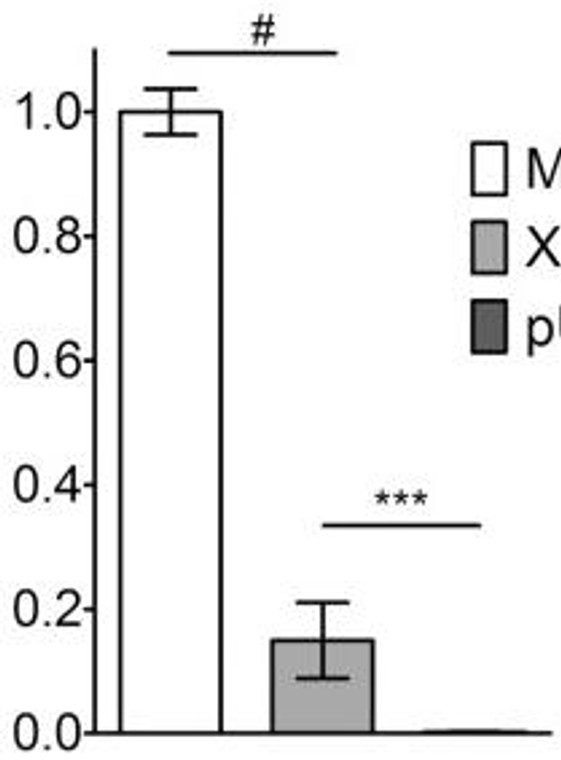| Host: |
CHO cells |
| Note: |
STRICTLY FOR FURTHER RESEARCH USE ONLY (RUO). MUST NOT TO BE USED IN DIAGNOSTIC OR THERAPEUTIC APPLICATIONS. |
| Short Description: |
Recombinant-Human Interferon-beta 1b-protein was developed from cho cells. For use in research applications. |
| Conjugation: |
Unconjugated |
| Formulation: |
Lyophilised from 0.2 Mu m filtered solution containing mM NaOAc pH.5. |
| Dilution Range: |
Spin the vial and reconstite in distilled water to a concentration not less than 0.1 mg/mL. This can then be diluted into other buffers. |
| Storage Instruction: |
Can be stored in working aliquots at°C-°C C for one month, or at-20°C C for six months, with a carrier protein without detectable loss of activity. Avoid repeated freeze/thaw cycles. NA |
| Endotoxin: |
Endotoxin content was assayed using a LAL gel clot method. Endotoxin level was found to be less than.1 ng/µg (1EU/µg). NA |
| Immunoreactivity: |
Theactivity was determined by the cytopathic inhibition assay of human WISH cells infected with the ECMV virus, and determined to bex107 IU/mg. NA |
| Gene Symbol: |
IFNB1 |
| Gene ID: |
3456 |
| Uniprot ID: |
IFNB_HUMAN |
| Immunogen Region: |
Mature chain |
| Immunogen: |
Optimized DNA sequence encoding Human beta Interferon 1b mature chain was expressed in Chinese Hamster Ovary cells. NA |
| Immunogen Sequence: |
MTNKCLLQIA LLLCFSTTAL SMSYNLLGFL QRSSNFQCQK LLWQLNGRLE YCLKDRMNFD IPEEIKQLQQ FQKEDAALTI YEMLQNIFAI FRQDSSSTGW NETIVENLLA NVYHQINHLK TVLEEKLEKE DFTRGKLMSS LHLKRYYGRI LHYLKAKEYS HCAWTIVRVE ILRNFYFINR LTGYLRN NA |
| Function | Type I interferon cytokine that plays a key role in the innate immune response to infection, developing tumors and other inflammatory stimuli. Signals via binding to high-affinity (IFNAR2) and low-affinity (IFNAR1) heterodimeric receptor, activating the canonical Jak-STAT signaling pathway resulting in transcriptional activation or repression of interferon-regulated genes that encode the effectors of the interferon response, such as antiviral proteins, regulators of cell proliferation and differentiation, and immunoregulatory proteins. Signals mostly via binding to a IFNAR1-IFNAR2 heterodimeric receptor, but can also function with IFNAR1 alone and independently of Jak-STAT pathways. Elicits a wide variety of responses, including antiviral and antibacterial activities, and can regulate the development of B-cells, myelopoiesis and lipopolysaccharide (LPS)-inducible production of tumor necrosis factor. Plays a role in neuronal homeostasis by regulating dopamine turnover and protecting dopaminergic neurons: acts by promoting neuronal autophagy and alpha-synuclein clearance, thereby preventing dopaminergic neuron loss. IFNB1 is more potent than interferon-alpha (IFN-alpha) in inducing the apoptotic and antiproliferative pathways required for control of tumor cell growth. |
| Protein Name | Interferon BetaIfn-BetaFibroblast Interferon |
| Database Links | Reactome: R-HSA-2559580Reactome: R-HSA-909733Reactome: R-HSA-912694Reactome: R-HSA-918233Reactome: R-HSA-933541Reactome: R-HSA-9705671Reactome: R-HSA-983231 |
| Cellular Localisation | Secreted |
| Alternative Protein Names | Interferon Beta proteinIfn-Beta proteinFibroblast Interferon proteinIFNB1 proteinIFB proteinIFNB protein |
Information sourced from Uniprot.org
12 months for antibodies. 6 months for ELISA Kits. Please see website T&Cs for further guidance


![Interferon gamma (IFN-Gamma ) 50 Mu l (100 ng/ml) was added to each dish in the experimental studies. The cytoplasmic and nuclear extracts were washed with ice-cold PBS and lysed in a 0. 5 ml/well lysis buffer (150 mmol/l NaCl, 20 mmol/l Tris, pH 7. 5,0. 1% Triton X-100, 1 mmol/l phenylmethylsulfonyl fluoride [PMSF] and 10 Mu g/ml aprotonin) as modified from the reports of Kim et al. and Moon et al. [](https://cdn11.bigcommerce.com/s-zso2xnchw9/images/stencil/760x760/products/151072/345150/STJP000324_2__71318.1679324302.jpg?c=1)




